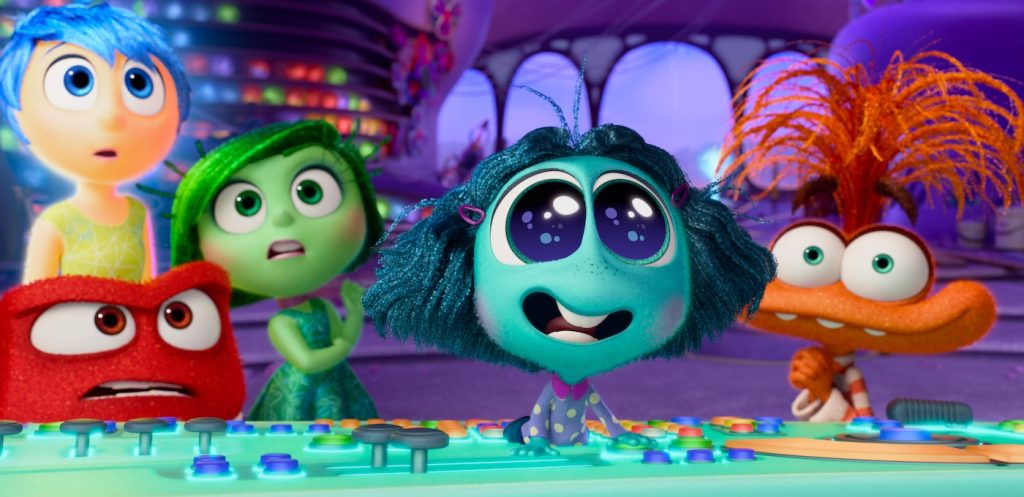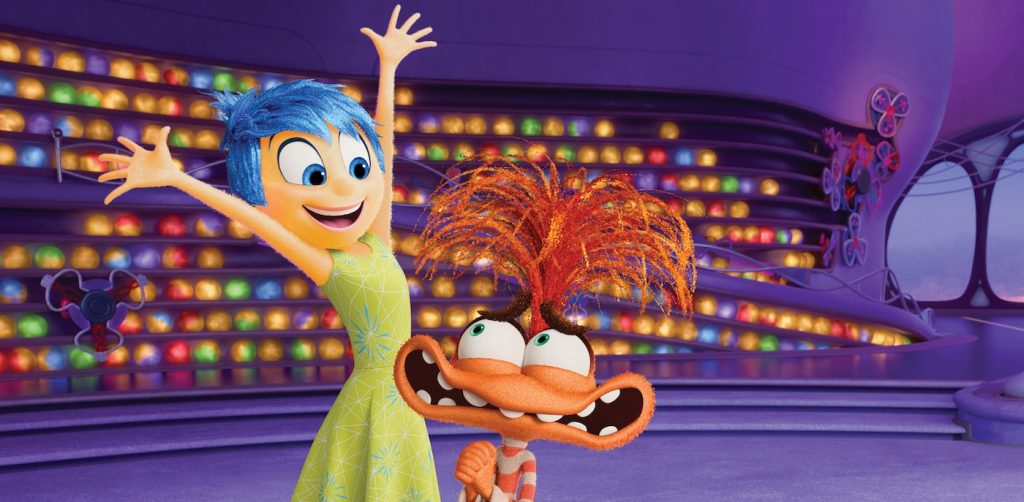“Inside Out 2” Screenwriter Dave Holstein on Anxiety Taking Center Stage
In Inside Out 2 (in theaters June 14), Riley (voiced by Kensington Tallman) is off to hockey camp in the summer before high school, no longer the little girl we remember from the sensational introduction we got nine years ago in Inside Out. Riley is now a 13-year-old tween in the liminal zone of adolescence, with a host of new emotions presenting themselves for the first time. So when the sirens go off again in the Headquarters of Riley’s brain, a new console is installed so these fresh emotions can join the original quintet from Pete Docter’s 2015 film. Joy (Amy Poehler), Sadness (Phyllis Smith), Anger (Lewis Black), Fear (Tony Hale), and Disgust (Liza Lapira) get repressed in favor of new emotions, including Ennui (Adèle Exarchopoulos), Envy (Ayo Edebiri), and Embarrassment (Paul Walter Hauser).
Key to the nearly impossible task of living up to the astonishment of the first film while forging a new emotive path was screenwriter Dave Holstein, who picked up the baton from Inside Out scribe Meg LeFauve and sprinted, fueled by the film’s most prominent new emotion, Anxiety (Maya Hawke), into dazzling new territory in the sequel. Working with director Kelsey Mann, Holstein leaped into the formidable but fecund Pixar Process (and across the Sarchasm—you’ll understand when you see the film) and made the most of the opportunity.
We spoke to Holstein about leveling up to Pixar’s high bar, what it’s like to write for comedic geniuses like Amy Poehler, and how he learned to love the challenge of scripting a movie that spoke to children and adults.
I’d love to hear about your writing process from the beginning when you mapped out the story for the sequel.
There was a strong desire not to retread the first movie and find something that felt resonant for today. I think anxiety really hit home. Anxiety is not a feeling you can destroy. There’s a certain lesson in learning to live with anxiety that had to feel different than living with sadness, you know, and that was sort of the original challenge of the piece; how to make it new and exciting and also give everyone what they love from the first film.
Was anxiety always the emotion you’d be exploring in the sequel?
We cycled through a few different ones. As with anything at Pixar, you’re constantly iterating to ensure you have the best possible collection of 800 puzzle pieces. But we all just went through this thing called COVID, and anxiety is not really an enemy you can defeat. It’s kind of something you have to learn to live with, and it felt like maybe there was a resonance to the anxiety that we’ve all experienced. I think there’s something important to the phrase: every pain needs a name. It just becomes a lot easier to talk about, especially with children, so that was a big part of anxiety as opposed to, say, shame or guilt, which were totally valid in other ways to play with antagonists. That’s how we kind of hatched that egg.
Tell me about the vaunted Pixar iteration and ideation process. I’m curious what that’s like as the writer from the inside.
Yeah. I mean, it’s like they come to you, and it’s like, “So you’ve written screenplays? Have you written screenplays inside a dishwasher?” I think that that’s always been my feeling is that you’re thrown into a process where everyone is constantly in all three stages of filmmaking at once—writing, shooting, and editing— and you’re constantly working in different parts of the movie and trying to make sure the pylons all build to something.
Writing a script inside a dishwasher sounds difficult.
It’s a very specific process because it’s a lot of pages. I think I wrote upwards of 750 pages on this movie. I guarantee you I have at least 11 drafts in my folder of the most important scenes in this film. It’s not even that hard to write a scene; there are plenty of great scenes, but the hard part is how they fit with everything around them. I kept trying to imagine myself doing the same process with a live-action film, and it doesn’t really work like that. There are just too many boxes to hit in a Pixar film.

Pixar films are well regarded for operating at multiple levels and truly appealing to the entire family, including adults without children.
There are so many levels it has to work on, both comedically and emotionally. It has to work on two different eye lines—for the adults and the kids. It has to make you feel something. It has to make you laugh. It has to make you want to watch it again. It has to make you want to see it in the theater. People say 3-dimensional chess. I think it’s like 8-dimensional backgammon. I’ve done a lot of different intense pipelines, I mean, I created a show for Jim Carrey that went for two years, so I’ve gone through different versions of insanity, you know? This was a very specific brand of great, but it was a lot of work.
How do you know when you’ve gotten it just right? Or can you ever truly know that until the movie is in theaters?
Yeah, I mean, that’s the thing you’re searching for the whole time. It’s not necessarily the moment when someone is crying, but it’s the moment when you feel something so emotional that it just puts you in a place. You want people to watch this film and say, “That really hit,” because that’s what we associate with Pixar. When you’re given the keys to Pixar kingdom and the tools and budgets they have, you feel this necessity to swing really, really, really hard, you know? And that doesn’t just mean more laughs per page. It means, “Can we figure out the secret to life in the next 94 minutes?”
That’s a lot of pressure, and the fact that you’re literally writing a film about anxiety adds to it.
You’re like, damn it, I’m in this self-fulfilling prophecy of a script. But if there’s nothing that can go horribly wrong, it’s kind of boring. This is what I signed up for.
What’s it like writing for animation? Does it change anything for your approach to crafting a satisfying story arc?
You know, it’s funny. I try to think about it as a drama first and just write adult stuff to see how I can find that sort of center lane. There’s a scene I’m very proud of where Joy breaks down. She’s like, I’m sick of being Joy all the time. You have these great actors like Amy Poehler who can do that, and you want to give these characters different shades. I think the trap in a film where you have Joy, Anger, Sadness, etcetera is that Joy, Anger, and Sadness are only happy, angry, and sad. And I think that what’s sort of fun is to dimensionalize characters that are so inherently one note, which is the same in a live-action, dramatic script. You’re always trying to find what feels like a real moment.

And I imagine it’s different writing alongside artists and animators.
The trick is just writing visually. I don’t think there’s a line of dialogue in the script that’s more than two horizontal lines on the page. You start to see the math of what you’re doing, and most of what has to be conveyed has to be conveyed with the eye. When I started writing on network sitcoms, being in a joke room was like a whole different muscle to train your brain. And I think that’s the jump for me—up at Pixar, you’re sitting in a room of a dozen story artists with pens in their hands, and I’m trying to speak their language so that I can convey what’s in my head to their head—it’s a totally a translation event.
How much are the film’s stars in your head when you’re writing their characters? Are you writing in a particular way to suit Amy Poehler’s gifts, for example?
It’s great writing a sequel when you can have Disney+ open in the background and play a scene from the first movie just to get their voices. But what’s really fun and kind of unexpected is when we were recording, that writer’s brain kind of fires up, and you start to hear new lines and feed them new ideas because their cadences or where they’re headed comedically is inspiring something. I was kind of surprised that we found on the day a line that’s 20% better than what was written, you know, or 20% darker in a lot of cases, frankly, with Phyllis [Smith, as Sadness] and Lewis [Black, as Anger]. A lot of those ended up in the movie. Like in the first movie, when Sadness says something like, “I loved that movie where the dog died,” I was like, Oh, we can do that. It’s totally dark, but it works.
Considering Anxiety is the big new character, what was it like when you finally heard Maya Hawke performing the role?
She really knocks it out of the park. Maya Hawke is phenomenal. Her interpretation of Anxiety is dimensionalized. She’s had a great rhythm. She’s one of the only characters I could write more than two lines of dialogue for. I could give her a big chunk, and she would sell it really well. And she wanted tongue twisters. She wanted what Jim Carrey wanted: a lot of verbal marbles to chew on, and that was really fun because I like a challenge, and she was really good at it.
And about another newcomer, Ayo Edebiri, as Envy?
Oh man, Ayo’s great. She’s such a born voice performer as well. She’s so funny, and she gave her character so many levels. I think because her character was so short she felt she had to have moments where she was up here and then down here. She was really fun to watch; she would go off on these riffs, which were like full monologues. And I would just sit there in awe. She’s the real deal. She’s really funny.
What does it feel like to be at the end of the road and have the film finally coming out?
[Holds up a toy version of Anxiety.] That’s kind of what it feels like, you know?
Inside Out 2 is in theaters on June 14.
For more stories on 20th Century Studios, Searchlight Pictures, Marvel Studios and what’s streaming or coming to
Disney+, check these out:
“The Acolyte” Composer Michael Abels on Scoring a “Star Wars” Story Unlike Any Before It
“Deadpool & Wolverine” Director Shawn Levy Eyed for Next “Avengers” Film
Featured image: Ayo Edebiri as the voice of Envy, “Inside Out 2” releases only in theaters June 14, 2024. © 2024 Disney/Pixar. All Rights Reserved.



